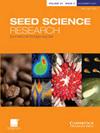亚美尼亚一种珍稀濒危全寄生物种——肉苁蓉的种子萌发
IF 1.9
3区 生物学
Q2 PLANT SCIENCES
引用次数: 0
摘要
专性根寄生虫肉苁蓉是最近重新发现的亚美尼亚特有的极为罕见的濒危物种,特别寄生在骆驼蓬(Alhagi maurorum,Fabaceae)和盐草(Salsola dendroides,藜科)。据说,由于栖息地的破坏和生物的影响,其种群数量正在下降。由于其繁殖的唯一已知方式是通过种子,因此从基础(功能生态学和进化)和应用(保护和管理)角度来看,了解打破山杏种子休眠和发芽的机制以及物种生物学的相关方面都非常重要。在这里,我们提出了第一个涉及氟烷酮的山杏种子体外发芽方案,氟烷酮是一种针对类胡萝卜素生物合成途径的系统性除草剂。此外,利用光学显微镜和共聚焦激光扫描显微镜观察的木质素自发荧光,描述了山杏种子的微观形态。首次描述了发芽山杏幼苗胚根细胞中的肌动蛋白细胞骨架,作为种子活力的证据。进一步阐述和应用拟议的发芽方案,在易感宿主上培养山杏,被视为保护该物种的宝贵工具。本文章由计算机程序翻译,如有差异,请以英文原文为准。
Seed germination of Cistanche armena (Orobanchaceae), a rare endangered holoparasitic species endemic to Armenia
The obligate root parasite Cistanche armena is a recently rediscovered, extremely rare endangered species endemic to Armenia, specifically parasitizing camelthorn (Alhagi maurorum, Fabaceae) and saltwort (Salsola dendroides, Chenopodiaceae). Its populations are reputedly declining due to habitat destruction and biotic impacts. Since the only known means of its reproduction is via the seeds, understanding the mechanisms of breaking C. armena seed dormancy and germination along with the related aspects of the species’ biology is highly important both from fundamental (functional ecology and evolution) and applied (conservation and management) perspectives. Here, we present the first in vitro seed germination protocol for C. armena involving fluridone, a systemic herbicide targeting the carotenoid biosynthetic pathway. In addition, the seed micromorphology of C. armena is described using both light microscopy and lignin autofluorescence visualized by confocal laser scanning microscopy. The actin cytoskeleton in radicle cells of germinated C. armena seedlings is described for the first time, being the proof of seed viability. Further elaboration and application of the proposed germination protocol with the cultivation of C. armena on susceptible hosts are altogether seen as a valuable tool for the conservation of this species.
求助全文
通过发布文献求助,成功后即可免费获取论文全文。
去求助
来源期刊

Seed Science Research
生物-植物科学
CiteScore
3.60
自引率
4.80%
发文量
23
审稿时长
>12 weeks
期刊介绍:
Seed Science Research, the official journal of the International Society for Seed Science, is a leading international journal featuring high-quality original papers and review articles on the fundamental aspects of seed science, reviewed by internationally distinguished editors. The emphasis is on the physiology, biochemistry, molecular biology and ecology of seeds.
 求助内容:
求助内容: 应助结果提醒方式:
应助结果提醒方式:


